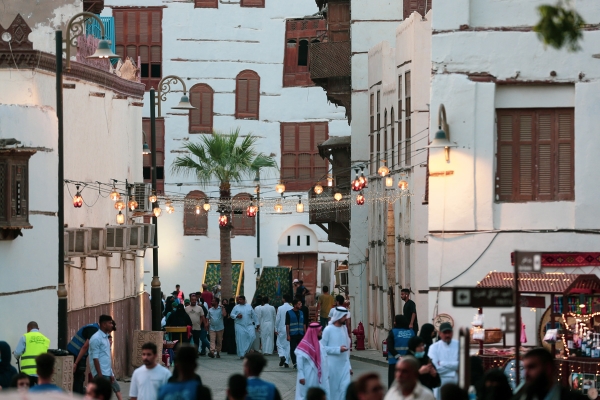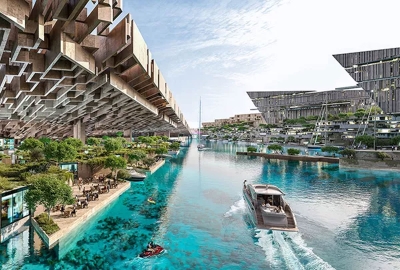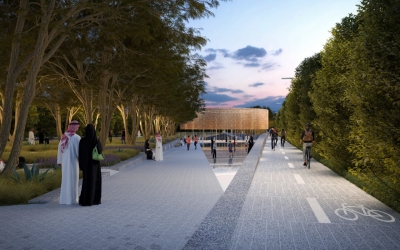

The Historic Jeddah Project Program is an initiative aimed at revitalizing Historic Jeddah, listed as a World Heritage Site by the United Nations Educational, Scientific and Cultural Organization 'UNESCO,' highlighting its heritage landmarks and enhancing its economic growth as a significant commercial hub on the eastern shore of the Red Sea.
The launch of the Historic Jeddah Project Program
On April 14, 2020, the Saudi Council of Ministers approved transforming the management of the Historic Jeddah Project into a program aimed at rehabilitating and developing it in the urban, economic, social, cultural, historical, and environmental fields. The program also addresses the provision of its needs for public facilities and services. On July 16, 2024, the council approved extending the program for an additional two years. The program is implemented by the Ministry of Culture.
Objectives of the Historic Jeddah Project Program
The Historic Jeddah Project Program aims to achieve sustainable development by creating an integrated environment with waterfronts and green spaces, highlighting the region’s heritage landmarks, and enhancing its importance. It seeks invest in history and cultural elements, transforming them into economic drivers, while improving the living environment to make it a business hub and a thriving space for cultural projects and creative production.
Additionally, the project seeks to create investment opportunities connected to the region's historical heritage, attracting entrepreneurs and offering logistical support to launch their businesses in the historic al-Balad District, as part of efforts to position Historic Jeddah as a major local, regional, and global destination.
Contents of Historic Jeddah
Historic Jeddah comprises over six hundred heritage houses, ranging in age from one hundred to four hundred years, with the oldest structure being al-Shafi'i Mosque minaret, which is 780 years old. The area also contains five main historical markets, thirty-six historical mosques, archaeological pathways and squares, important historical sites, as well as the old waterfront, which was once a main route for pilgrims. The development tracks of the Historic Jeddah Project include enhancing the natural and environmental landscape, upgrading infrastructure and services, strengthening urban aspects, and improving the quality of life. The project also involves restoring fifty heritage houses, transforming them into venues for development projects, boutique hotels, Ministry of Culture offices, museums, and educational buildings, including the Royal Institute of Traditional Arts.
Jeddah Historical Rejuvenation Project
The Jeddah Historical Rejuvenation Project emerged as part of the Historic Jeddah Development Program, which was announced on September 6, 2021. The project spans fifteen years, during which Historic Jeddah will be developed through multiple tracks, including infrastructure and service, enhancing the natural and environmental landscape, improving the quality of life, and strengthening urban aspects.
The area of the Jeddah Historical Rejuvenation Project is 2.5 km², and the project aims to create five km of developed waterfronts, along with green spaces and open gardens spaces and open gardens that will cover 15 percent of the total area of Jeddah’s al-Balad. The project utilizes these natural features by transforming them into elements that support a healthy and sustainable environment, free from the causes of environmental pollution.
In the restoration process, the Jeddah Historical Rejuvenation Project uses the same materials originally used to build the historical homes, including limstone (Manqabi ), coral stone, wood for doors and ceilings, gypsum for decorative elements inside and outside homes, and the traditional lime mixture known as noura. Historical records were referenced when reconstructing demolished homes, relying on documented sources and architectural surveys that revealed the locations of windows and entrances. As the launch of the Historic Jeddah Project coincided with the documentation of the houses in the area. Among the restored buildings is Zakir House, which was rebuilt to its original form within a year of the project's commencement.
Jeddah Historic District's Waterfront Project
One of the components of the Jeddah Historical Project Program is the Jeddah Historical Waterfront Development Project. Its first phase focuses on restoring the waterfront by re-digging the sea area that had been filled in due to urban expansion. The second phase involves addressing the pollution of the Forty (al-Arbaeen) Lake and developing infrastructure to establish an urban area and waterfront. The third phase includes creating green spaces, constructing a yacht marina, public facilities, and pedestrian bridges.
The Jeddah Historical Waterfront Development Project aims to restore the sea water to al-Bunt Port as closely as possible to its original state. It seeks to create a natural environment with waterfronts, develop the infrastructure and facilities, and ensure a sustainable environment surrounding the waterfront area. The project is part of a comprehensive vision to develop the area surrounding the waterfront, which includes a yacht marina, new residential and hotel districts to the north and south of the lake, as well as markets and restaurants that contribute to creating a sustainable residential and commercial community.
Archaeological discoveries of Jeddah Historical Project Program
Although the Jeddah Historical Project Program is a development program, it has contributed to multiple archaeological discoveries. The archaeological work in of the Jeddah Historical Project began in 2020. The project commenced with exploratory studies and conducting geophysical surveys to uncover submerged features beneath the ground at four historical sites: Uthman Bin Affan Mosque, al-Shounah site, parts of the northern wall, and al-Kadwah area (Bab Makkah).
In 2024, the Jeddah Historical Program and the Heritage Commission announced the discovery of approximately twenty-five thousand archaeological remains, the oldest of which date back to the first and second centuries CE. These discoveries were made at four historical sites: Uthman Bin Affan Mosque, al-Shounah archaeological site, parts of the Eastern Trench, and the Northern Wall. Archaeological surveying and excavation efforts resulted in the discovery of 11,405 ceramic artifacts, 11,360 animal bones, 1,730 shell items, 685 construction materials, 191 glass pieces, and seventy-two metal objects.
Studies conducted at Uthman Bin Affan Mosque revealed archaeological materials dating back to the seventh and eighth centuries, spanning Umayyad, Abbasid, and Mamluk periods, extending into the modern era in the early twenty-first century.
Among the most significant discoveries were two ebony wood columns from the island of Ceylon, placed on either side of the mosque’s mihrab as decorative elements. These columns date back to the seventh and eighth centuries and are considered some of the oldest artifacts uncovered at the site. Additionally, a collection of ceramic vessels and high-quality porcelain pieces was discovered, some originating from Kilns of 'Jiangxi' Province in China between the sixteenth and nineteenth centuries CE. The findings also included pottery bowls dating back to the Abbasid period.
The archaeological studies conducted as part of the Jeddah Historical Project revealed the historical architectural patterns of Uthman Bin Affan Mosque and uncovered hundreds of archaeological remains, some dating back approximately 1,200 years. Archaeological studies revealed successive restoration processes of the mosque. All previous construction phases adhered to the traditional architectural style prevalent in Jeddah at the time, characterized by an open courtyard and a roofed prayer hall. The only exception was the final construction phase, reflecting the mosque’s current structure built in the late twentieth century. However, the mihrab and the mosque’s overall area remained unchanged for over one thousand years. Most restoration and renovation efforts in the mosque focused on the floor elevation and its patterns, which varied from clay tiles and plaster to traditional tiles. The use of tiles continued for four hundred years, with studies indicating that since the end of the Mamluk period (the fifteenth and sixteenth centuries CE), builders raised the floor at each stage of restoration, reusing the same tiles until the early twentieth century CE. One of the significant changes to the mosque was the construction of an underground water reservoir beneath it. Archaeologists discovered underground tanks filled with pure water, left by the builders approximately eight hundred years ago.
Fragments of Chinese blue-and-white porcelain dating back to the seventeenth century CE were discovered in Uthman Bin Affan Mosque. Additionally, Chinese celadon, glazed in shades of gray and green and dating back to the eleventh to thirteenth centuries CE, was uncovered. Shards of pottery glazed in white, green, and yellow, dating back to the ninth and tenth centuries CE, were also found.
The architectural remains discovered at al-Shounah archaeological site date back to the nineteenth century CE, with evidence of older archaeological remains traced to the sixteenth century CE. Additionally, pottery fragments, including porcelain and other types of ceramics from Europe, Japan, and China, were found, dating between the nineteenth and twentieth centuries CE.
Archaeological studies have revealed that al-Shounah building underwent significant adaptations over the centuries to serve various purposes. Researchers suggest that the fortified building's construction dates back to the Mamluk period, between the fifteenth and sixteenth centuries CE. The discovery of a fortified tower at one corner of the structure, along with four iron cannonballs and one stone cannon shell found at the site, indicates that the location might have been used as an armory or military garrison.
Archaeologists at al-Shouna archaeological site discovered pieces of fine Chinese porcelain dating back to the eighteenth and nineteenth centuries CE. During this period, al-Shounah served as a government storage facility for grain, timber, and ammunition. In the twentieth century, al-Shounah functioned as a private warehouse for a merchant storing imported goods. Discoveries at the site suggest that Jeddah, a key trading hub on the Red Sea coast, maintained strong connections with the Asian trade network and later with European commerce.
Excavations at the al-Kadwah site (Bab Makkah) uncovered tombstones made of hewn stone, granite, and marble inscribed with names, condolences, and Quranic verses. These artifacts date back to the eighth and ninth centuries CE and were found in historical cemeteries of Jeddah.
Additionally, archaeological excavations in Historic Jeddah revealed remnants of a defensive trench and a fortification wall that once encircled the city. These structures are located in the northern part of Historic Jeddah, east of al-Kadwah Square and near al-Bay'ah Square, dating back several centuries.
Related quizzes
Related articles

